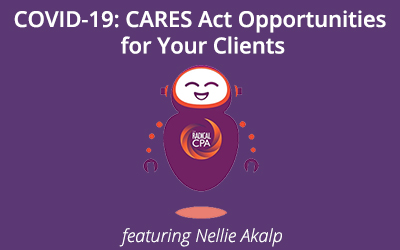There is opportunity in chaos. We’ve heard this before, but maybe the intent is a little lost at the moment. I mean, we’re still in the thick of it: changing loan regulations, tax season, working at home with kids underfoot. It’s definitely not easy. But there are opportunities for you, your firms, and your clients through the CARES Act.
In a recent Let’s Get Radical … Live session, I interviewed Nellie Akalp, entrepreneur and CEO of CorpNet. Nellie is also a personal friend, so it was great to sit down and talk with her on how she has been helping CPAs and small businesses learn about the CARES Act and opportunities for their clients.Â

The accountant’s role has become even more important in the eyes of the small business owner, Nellie explained, because the businesses are really counting on us to be there for them and help them through this crisis. We are the ones who can provide the financials that they need to apply for financial relief. She went on to say that this is actually an ideal time to expand service offerings and gain new clients by offering incorporation LLC filings, entity creation and compliance services, and by offering relief options available through the CARES Act. More than ever, it’s time to think long-term; when the client receives that money from the SBA, how can you and your firm assist them in managing the funds? Cash flow management becomes really important, right now, through the end of the year, and beyond.
CorpNet has sort of become an expert in the CARES Act, and Nellie talked about the three main programs available when our interview aired (sidenote: all of this information is current when I talked to Nellie, but all we know by now that things can change daily so don’t be surprised if components of these loan programs, that we talk about here today, change in the coming days or weeks). One program is a 100 percent forgivable loan, if they qualify. Then there’s the economic injury disaster loan through the SBA, and the EIDL loan advance of up to $10,000. Nellie broke it down for us:
The Paycheck Protection Program is available to any small business owner with 500 employees or less. It’s a loan that will need paid back. The 100 percent forgivable portion of the loan can be used to cover payroll expenses; so if you’ve laid off some employees, now is the time to bring them back. The forgivable portion of the loan extends eight weeks following the funding, known as the covered period. So as long as you use this loan for payroll costs, insurance premiums for health care, health care, benefits for your employees, rent, utilities expense, anything that’s approved under the PPP program, then the small business owner can get up to 100 percent of this loan – under the covered period – forgiven. If any portion of this loan becomes unprovable from the state, then it turns into a loan that’s payable over a two-year period at a fixed one percent interest rate. That’s the PPP loan in a nutshell.
Nellie’s view is that any business with fewer than 500 employees, a sole proprietor, or an independent contractor, it absolutely makes sense to apply. What’s the worst that can happen? A rejection. But if you have all your documents and you and upload them and apply for the loan, then go for it, she said. It’s intended to help small business owners get back on their feet and go back to a new normal, as they say. More importantly, if you have an existing relationship with your bank, go to your bank first, especially since your bank may already be an SBA-approved lender.
CorpNet is getting a lot of feedback that the bigger banks have stopped taking applications and has been helping clients navigate other resources. And during the course of those conversations about loan applications, a few common errors have come up repeatedly.
Nellie first mentioned that many small business owners are sort of scrambling to get the correct financial information because a lot of them don’t know what is, for example, the cost of goods sold, or what is considered revenue and what is not. She went on to explain, as we already know, that these applications need to provide a lot of information, both on the EIDL loan and the PPP. So that’s a place – information accuracy – that CPA firms can naturally assist. But when we get overwhelmed with this stuff, it’s good to know that a business or referral partner like CorpNet exists that knows the ins and outs of these applications and can step in to advise clients, too. Or, to act as a silent fulfillment partner for our firms to facilitate the application process.Â
Another area that Nellie mentioned has been getting a lot of attention on these applications for small businesses is the hole in documentation from an entity creation standpoint. Most small businesses don’t keep certifications of good standing or articles of incorporation on hand, but these documents are considered to be necessary for the loan applications. This is another area where CorpNet has been assisting small businesses, from articles of incorporation to developing bylaws or operating agreements.
We also need to keep in mind and communicate to our CPA firm clients that PPP loan funds in particular are first come, first serve. And there might be another round of funding when Congress is back in session, but it’s not a guarantee.
Nellie and I then reminisced about the not so distant past where the SBA website was down for several days because their server crashed. Remember that too? It was an eternity and we wanted to pull our hair out, right?!
The SBA has since decided to fast track the entire application and minimize the information intake process. The next iteration of this was that little checkbox asking if you/the application are interested in the $10,000 cash advance. If yes, another box would open up, requiring the applicant to put in their bank routing number and account number and all of that. And then, boom, two or three weeks later, the money is, or should be, in your account. Much easier than the initial process.
Nellie also told us how the SBA is fast tracking practically any loan up to $500,000. Loans of this size or smaller are not being assigned to a loan processor. As long as all the required documentation is in order, and the application is accurate, it’s getting pushed through pretty quickly.
Moving on the EIDL loans. My readers already know the loan terms but it may bear repeating for our clients: even if the max is $2 million, the SBA decides how much the applicant gets. Â
Next up, the Small Business Debt Relief Program is something that applies to small business owners who already have existing loans with the SBA. So if this is your client, they would reach out to the SBA and ask for debt relief. The SBA is already deferring, Nellie said, for three to six months. But on top on that, small business owners can and should be asking for additional debt relief where maybe some of those loans can be forgiven.
Express bridge loans are yet another option here. Small businesses would apply for these bridge loans, through the CARES Act, with their bank. Originally, the max amount was $350,000 with an immediate bridge loan amount of up to $25,000 as a cash advance. Once the CARES Act was signed into law, however, SBA bridge loans were expanded to $1 million. These loans have a capped interest rate and a payback period of up to seven years, and still might require collateral and a credit check. These are more traditional loans, Nellie said.
As CPAs, we have been studying the CARES Act and helping clients prepare the financials for the applications, and in many cases walking clients through the actual process of applying for funds. So it’s really important to know ALL the funding options so we can present our clients with a very clear picture of what’s available to them and what the best course of action is going to be.
We’ve been on the frontline of this from the beginning, so while the application process now might be light years ahead of where it was two weeks ago, we also need to remember that our role is to continually adapt and read the situation as it is, not how we would like it to be.
We also need to remind clients and keep communicating with them about the quality of their financials. It’s our role to help small businesses understand what’s in their financial reports, what the numbers mean, and how that all adds up to a successful business. What CorpNet has been finding is that a lot of small businesses just don’t have this kind of information, like projections or cash flow analysis and whatnot. We can and should be talking with our clients about syncing up and developing a plan to get these financials in order now, and for the future.
Jumping off from that point, Nellie suggested that CPAs are in a perfect position to charge a set package fee. In this scenario, the assistance with the loan application is free – but the cash flow management is a valuable service that can be charged for.
I want to close this out by remembering Nellie’s positive vibes and great energy and passion for what she does. She said, and I truly believe this also, that there is a silver lining to all this madness, and there IS a light at the end of the tunnel. We will come out of this stronger and better.
You can listen to the full interview below and find out who plays the guitar that is hanging on the wall in Nellie’s background.

0 Comments